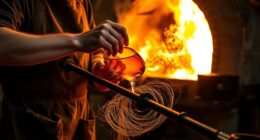Stains, often seen as flaws, are undergoing a creative renaissance to become captivating art pieces. Crafted through innovative methods like coffee or gel staining, artists are challenging conventions with enthralling creations. Embracing imperfections helps forge unique artworks that connect with viewers on an emotional level. Techniques involving shading and unconventional tools like water-based gel stain bring forth visually appealing results. Renowned artists like Jette Reinert and historical figures such as Max Ernst have elevated stain art to new heights. Modern culture celebrates these pieces for their intricate textures and color interplay, offering a unique form of expression. An exploration into the world of stain art reveals a rich tapestry of creativity and beauty.
Key Takeaways
- Embrace imperfections for unique beauty in stain art.
- Explore unconventional materials for surprising artistic results.
- Experiment with vibrant colors and textures in stain creations.
- Use innovative techniques to push boundaries in stain art.
- Find beauty in chaos through expressive and captivating stain artworks.
The Evolution of Stain Art
Stain art has transformed over time from accidental spills to deliberate techniques like coffee staining and gel staining. Artists are going beyond traditional methods to explore new possibilities in stain art.
One particularly remarkable trend is the use of Gel Stain, which offers a wide range of colors and textures for artists to experiment with. By incorporating Gel Stain into their work, artists are going in a new direction, creating vibrant and dynamic pieces that captivate viewers.
In this Going New Series, artists are pushing the boundaries of stain art by incorporating innovative techniques and materials. This evolution in stain art has led to the creation of stunning and surprising pieces that challenge traditional notions of what stain art can be.
Embracing Imperfections

Moving beyond traditional methods, artists in stain art embrace imperfections as opportunities for creativity and innovation. Embracing imperfections allows artists to explore new avenues of expression, turning accidental spills and smudges into captivating artworks. By accepting the unpredictable nature of stains, artists can harness the beauty of imperfection to create unique pieces that resonate with viewers on a deeper level. The organic and authentic feel of these artworks adds a sense of raw beauty and emotion that traditional techniques may not capture. Through the lens of imperfection, artists find freedom to experiment and push boundaries, resulting in art that surprises and delights.
| Embracing Imperfections | Opportunity for Creativity | Unique Artworks | Captivating Viewers |
|---|---|---|---|
| Allows for exploration | Encourages innovation | Adds depth | Evokes emotions |
| Embraces unpredictability | Fosters artistic freedom | Creates intrigue | Connects with viewers |
| Transforms mistakes | Inspires experimentation | Sparks curiosity | Provokes contemplation |
Techniques and Tools

Artistic stain application involves utilizing techniques like 'Shading with Stain' to create visually appealing art pieces.
Unconventional tools such as water-based Gel Stain by Shabby Paints and Unicorn Spit are commonly used in staining projects.
Experimenting with stipling paintbrush techniques can help artists achieve unique and intricate effects in their stained art creations.
Artistic Stain Application
Various tools and techniques are essential in the creation of beautiful art pieces using stains. Artists often employ techniques such as 'Shading with Stain' to achieve stunning effects. Common tools utilized in artistic stain application include water-based gel stains, Unicorn Spit, and stipling paintbrushes. These tools enable artists to manipulate the stains and create intricate designs.
Staining techniques may involve tracing images onto transparency, projecting them onto wood, and meticulously tracing with a pencil to achieve precision in the final artwork. To foster creativity and innovation, artists recommend experimenting with staining techniques on scrap wood to explore different possibilities without feeling pressured to produce a perfect piece.
Additionally, community engagement plays a significant role in this art form, with artists sharing tutorials, projects, and inspiring others to try new staining techniques. By utilizing various tools and techniques, artists can create stunning pieces of art that showcase the beauty and versatility of stains.
Unconventional Tools for Staining
Artists exploring the world of staining art pieces often turn to unconventional tools and techniques, such as coffee, gel stains, and syringes, to create unique visual effects and stunning results. These techniques go beyond traditional brushes and paints, allowing for innovative ways to manipulate colors and textures in their artwork.
By employing shading with stain and suction manipulation, artists can achieve intricate details and depth in their pieces. The use of water-based stains like Boom Gel Stain not only provides a wide range of colors but also guarantees safety from fumes during the staining process.
Experimentation with paint movement, composition adjustment, and color balance further enhances the final outcome, showcasing the beauty, uniqueness, and the artist's confidence in the staining techniques employed.
Famous Stain Artists

Jette Reinert is a prominent stain artist celebrated for her vibrant and whimsical creations using coffee stains. Her unique artistic process integrates coffee stains as an essential component, yielding distinctive patterns and textures in her pieces.
Reinert's artwork is characterized by a blend of abstract and figurative elements, including metallic accents and checkerboard patterns.
Stain Artist Techniques
Utilizing spilled coffee stains as a starting point, stain artists like Jette Reinert transfer unique patterns onto canvas to create their signature artworks. These artists infuse whimsical elements, checkerboard patterns, and metallic accents into their creations, resulting in joyful and celebratory pieces. Key techniques employed by stain artists include coffee stain transfers, abstract paintings, and intentional contrasting elements, all contributing to their distinct artistic style.
Experimentation with acrylic paint, mixed media, and metallic inks is common among stain artists like Jette Reinert, enhancing their pieces with depth and texture.
Through their art, stain artists convey themes of joy, inspiration, and feminine strength, aiming to uplift and bring waves of joy to viewers. The incorporation of various techniques and materials allows stain artists to create visually enchanting pieces that evoke positive emotions and showcase their unique artistic vision.
Historical Stain Art
In historical stain art, renowned artists such as Max Ernst and Jean Dubuffet prominently featured accidental stains in their works.
Max Ernst, known for his frottage technique, created textured patterns resembling stains by rubbing graphite or other materials on paper. Similarly, Jean Dubuffet embraced unconventional materials and techniques in his art brut style, incorporating stains and smudges into his works.
These artists used stains symbolically to represent artistic freedom, spontaneity, and a departure from traditional artistic norms. By incorporating accidental marks and imperfections, they paved the way for contemporary stain art, inspiring modern creators to embrace similar approaches.
Through their innovative use of stains, Ernst and Dubuffet demonstrated how accidental elements can enhance the beauty and depth of artworks, challenging conventional artistic practices and expanding the boundaries of artistic expression.
Unique Stain Materials
Michele at Simplify Live Love showcases the versatility of Gel Stain and Unicorn Spit in creating vibrant sunflower art on Alder wood. Jette Reinert draws inspiration from coffee stains, infusing whimsical elements and checkerboard patterns into her distinctive style.
Karen from Waterfall Colx opts for Boom Gel Stain in her fluid art, exploring various color palettes and experimental techniques. The use of Gel Stain and Unicorn Spit by Michele highlights the innovative ways artists employ unconventional materials to produce stunning artwork.
Boom Gel Stain offers a wide range of colors like Dark Blue Pearlescent, Sage, and Dark Violet MGA, allowing artists like Karen to express their creativity through unique stain materials. Artists such as Jette Reinert and Karen exemplify how unconventional stain materials can enhance the beauty and creativity of artwork, proving that artistic ingenuity knows no bounds when it comes to creating captivating pieces with unexpected mediums.
Stain Art in Modern Culture

Stain art in modern culture has emerged as a fascinating and unconventional form of artistic expression. Artists like Jette Reinert have propelled stain art into the spotlight, utilizing mediums such as coffee, wine, and gel stains to create vibrant and whimsical pieces. This contemporary approach to creativity allows for experimentation with techniques like shading, stipling, and painting manipulation, resulting in intricate textures and patterns that captivate the viewer's imagination.
The rising popularity of stain art is evident on social media platforms, where artists share tutorials, techniques, and finished pieces to inspire a growing audience. This trend reflects a modern artistic sensibility that combines traditional methods with innovative tools and materials. By blending these elements, artists produce visually stunning and thought-provoking artworks that challenge conventional notions of what constitutes art.
Stain art in modern culture serves as a confirmation to the endless possibilities of creative expression and the enduring appeal of unconventional mediums in the art world.
Exploring Color and Texture

Through careful experimentation, artists can achieve a stunning interplay of color and texture in stain art pieces. Coffee stains on canvas, when manipulated using various techniques, can be transformed into beautiful artworks that showcase a harmonious blend of hues and textures.
Additionally, Gel Stain products like Boom Gel Stain offer artists a palette to create striking color effects in their pieces. Techniques such as 'Shading with Stain' provide a platform for artists to infuse their creations with unique textures and patterns, adding depth and visual interest to their work.
Stains as a Form of Expression

In the domain of artistic expression, stains offer a unique and enthralling medium for creative exploration. Artists like Jette Reinert draw inspiration from coffee stains, utilizing them in their creative process. These stains can be manipulated and transformed into intricate patterns on canvas, employing various techniques to enhance their aesthetic appeal. By incorporating stains into their art, creators can infuse depth, texture, and a touch of whimsy into their final pieces, adding layers of complexity and visual interest. Stains in art not only showcase the beauty of imperfections but also highlight the transformative power of creativity, turning something seemingly mundane into a work of art that captivates the viewer.
| Emotion | Description |
|---|---|
| Intrigue | Stains provoke curiosity, inviting viewers to explore the hidden narratives within the artwork. |
| Wonder | The unpredictable nature of stains can evoke a sense of wonder and amazement at the beauty they create. |
| Playfulness | Stains add a playful element to art, encouraging a light-hearted and imaginative interpretation of the piece. |
Finding Beauty in Chaos

Finding beauty in chaos, artists like Jette Reinert embrace spilled coffee as a medium to showcase their artistic ability to transform unpredictability into visually enthralling creations. By viewing spilled coffee not as a mess to clean up, but as a potential canvas for art, these artists turn what could be considered chaotic into something mesmerizing.
The intricate patterns and designs that emerge from coffee stains serve as a tribute to the creative vision of these artists. Techniques such as shading with stains and the addition of metallic ink further elevate the beauty of these unconventional art pieces.
Through their work, artists like Reinert demonstrate a keen eye for finding beauty in unexpected places. The ability to see art in everyday accidents like spilled coffee is a tribute to their artistic talent and imagination. By embracing chaos and incorporating it into their creative process, these artists produce unique and visually appealing creations that challenge traditional notions of art.
Tips for Creating Your Own Stain Art

Experimenting with various staining techniques can lead to the creation of unique and engaging art pieces. To help you get started on your stain art journey, here are some tips to explore:
- Try Different Staining Techniques:
- Experiment with a variety of staining methods such as coffee stains, gel stains, or Unicorn Spit to discover which ones resonate with your artistic vision.
- Utilize a Range of Tools:
- Use tools like brushes, syringes, or stencils to manipulate the staining process and achieve desired effects in your artwork.
- Enhance Your Artwork:
- Incorporate elements like metallic inks, gold leaf accents, or checkerboard patterns to elevate the visual appeal of your stain art and add depth to your creations.
Frequently Asked Questions
What Is Considered the Most Beautiful Art?
The beauty of art is subjective, with various styles and genres appealing to different individuals. Factors such as composition, color palette, technique, and emotional resonance contribute to what's considered beautiful in art.
From classical masterpieces to contemporary creations, art lovers find beauty in diverse forms, each piece evoking different responses and connections. Ultimately, the most beautiful art is a personal interpretation that speaks to the viewer on a profound level, transcending mere aesthetics.
What Is a Stain in Art?
A stain in art refers to accidental or intentional marks left by liquids on a surface like paper or canvas.
Artists often incorporate stains into their work by highlighting, enhancing, or transforming them into intricate patterns or designs.
Stains can add depth, texture, and visual interest to artworks, creating a sense of spontaneity and organic beauty.
They allow artists to explore unconventional techniques and celebrate the beauty found in imperfection and chance encounters.
What Is It Called When a Painting Has Unrealistic Colors?
When a painting features unrealistic colors, it's often referred to as nonrepresentational or abstract art. These colors can evoke emotions, challenge perceptions, and spark creativity in viewers.
Artists use unrealistic colors to convey unique perspectives, explore symbolism, and express personal experiences. Nontraditional color choices create visual interest, depth, and a sense of whimsy or mystery.
Unrealistic colors in art break away from realism, allowing artists to experiment with imagination and push boundaries in their creative expression.
What Famous Artist Uses Dots?
One famous artist known for utilizing dots in her work is Yayoi Kusama. Kusama's intricate dot patterns have become her signature style, featured prominently in installations like 'Infinity Mirrored Room' and 'Pumpkin.'
These mesmerizing dot motifs symbolize her personal experiences with mental illness and her fascination with infinity. Through her innovative use of dots, Kusama has established herself as one of the most influential contemporary artists worldwide.
Conclusion
To sum up, stain art is a unique and mesmerizing form of expression that showcases the beauty in imperfections. As the saying goes, 'beauty is in the eye of the beholder,' and stain art certainly proves this to be true.
By embracing the unexpected and finding beauty in chaos, artists are able to create stunning works that challenge traditional notions of art.
So next time you see a stain, don't immediately reach for the cleaning supplies – you may just be looking at a masterpiece in disguise.









